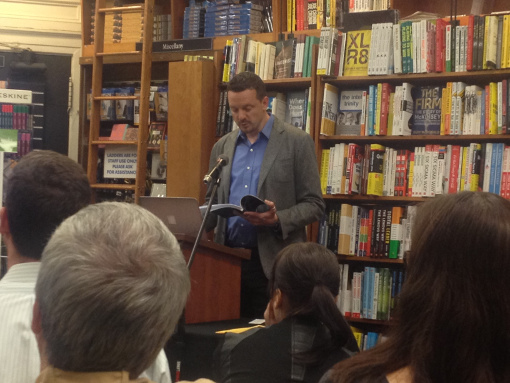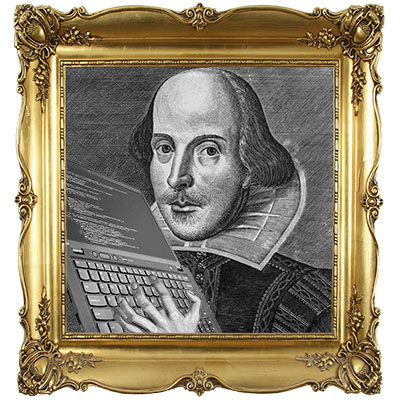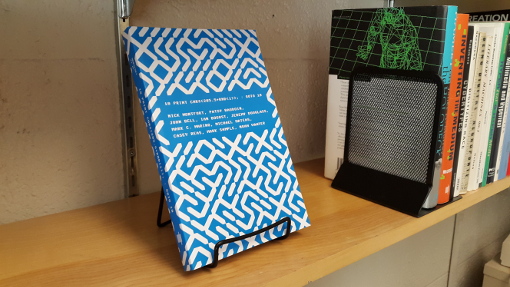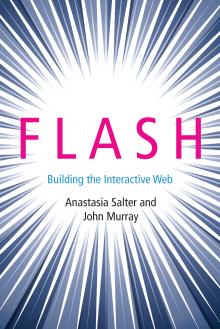The site Unglue.it, which offers books that can be made free after a certain number of purchases, also promotes born-free e-books such as the Creative Commons PDF of 10 PRINT CHR$(205.5+RND(1)); : GOTO 10. They have featured our book today, in fact. The founder pointed out to us that there are now 11 different “editions” of 10 PRINT in WorldCat, thanks not to the hardback, paperback, and e-book editions but to variant titles and author entries.
La Mort Des Imagistes
Students published the first digital Des Imagistes in 2008, chose to self-host it without sending me a copy. It’s gone.
Wired: It’s up on the Internet Archive. Tired: Without scraping that I can’t get the CC BY-NC-SA site.
Beautiful class project. The preservation strategy was not so great. I should have required the files be sent to me, too. Live, learn.
The First Review of #!
Finally, the first review of my book #! is in. It’s from Zach Whalen. this is it, and to make it easier for you to copy, paste, and run it, here is the review that he banged out:
perl -e '{print$,=$"x($.+=.05),map{$_ x($.*.1)}qw(# !);redo}'
By the way, please come to my reading tomorrow at MIT (E15 atrium) at 6:30pm if you’re in the area. It will be fun!
#! Reading at MIT, Wednesday, 6:30pm
Nick Montfort presents #! in the atrium of MIT’s building E15, just steps from the Kendall T stop. It’s October 22, Wednesday, at 6:30pm, and thanks to the List Visual Arts Center. The book is Montfort’s new one from Counterpath Press, consisting of programs and poems. Please, come join me!
Computational Media Department at UCSC
Michael Mateas looks even more smug than normal – and he should – in the photo accompanying this UC Santa Cruz press release. He’s the chair of the new Computational Media department at that UC school, the first of its sort.
My collaborator & friend Michael, along with my collaborator & friend Noah Wardrip-Fruin, have made good on the suggestions of the report “Envisioning the Future of Computational Media,” the outcome of an NEH-, NEA-, NSF-, and Microsoft-sponsored workshop of which I was a part, along with about 40 others.
I’m glad, too, that Michael expressed how, while games are a critical part of computational media, the field’s potential goes beyond the current state of computer and video gaming.
It looks like computational media has a great future in Santa Cruz!
Interview: “Eksperymentalna literatura Nicka Montforta”
Here’s an interview of mine, in Polish and posted on the site interia.pl. World Clock is among the topics.
Yes, Post Position will be switching over to all-Polish programming soon. But in the meantime we’ll have a few more posts in English.
World Clock in Polish Reviewed (in Polish)
I announced the Polish translation of World Clock recently; here is, as far as I know, the first review of it – which is also the first review of World Clock in any language. It will appear in the magazine Fragile.
„TRAVELOGUE” WIERSZA WOLNEGO NICKA MONTFORTA
Nick Montfort, Zegar światowy, tłum. Z jęz. ang. przełożył Piotr Marecki, Kraków, Korporacja Ha!art, 2014.
Ciekawie przedstawiono w książce autentyczne przemówienie, w którym narrator mówi głosami innych osób. Autor nie tylko opowiada zdarzenie, ale pisząc, że tak było zwraca też uwagę na to, jak do tego doszło: „Ashgabat. Jest prawie 05:04. W pewnym przytulnym schronieniu sporej postury mężczyzna, o imieniu Jakub, czyta kanarkową umowę. Siada prosto”. Kategorii narratora szybko zmienia „punkt widzenia”.
Forma książki to proza poetycka z elementami pamiętnika, po prostu chronologia uczucia. Za to motyw napisania tekstu przypomina „travelogue”, ponieważ zawiera krótkie notatki z podróży. W składni poetyckiej odgrywa ważną rolę elipsa (opuszczanie słów, a nawet całych zdań) : „Samara. Jest około 12:39. W pewnym miłym miejscu zamieszkania średniej postury mężczyzna, nazywany Liang, czyta nieskazitelnie czystą kartkę. Całkowicie się wyłącza”. Ograniczenia krótkimi wyrażeniami wymuszają na czytelniku wymyślanie sytuacji, to jest oryginalną interakcję między autorem a czytelnikiem. W ten sposób autor zaprasza do dialogu.
Struktura tekstu to mozaika, czytanie jest „rozdrobnione”. Możesz czytać książkę zarówno klasycznie, od początku do końca, jak też chaotycznie, otwierając ją na dowolnej stronie, co jednak nie powoduje uszkodzenia jej koncepcji. Styl pisania jest podobny do „nowego dziennikarstwa” (Tom Wulf, USA). Zmiana perspektywy (tzw. „kameleon”) to jedna z najbardziej interesujących i sprytnych technik. W ten sposób za pośrednictwem narratora autor gra z czytelnikiem. W związku z tym ważne jest również, aby pamiętać o zmienianiu „punktu widzenia”, o patrzeniu z cudzej perspektywy i opisywaniu wydarzeń postrzeganych przez różne osoby. Postaci to w Asmari, to w Tunisi. Postaciami są raz kobiety, raz mężczyźni. Zmiana płci i zmiana miejsca to ciekawe elementy gry autora. Ważne jest, aby zrozumieć, że podstawową zasadą dziennikarstwa jest prawdą, a Nick Montfort ignoruje wszelkie zasady i dlatego jest inny.
Jego tekst – ciągły wiersz wolny, który ma różne ciągi długości, bez rymów, ale z rytmem:
Port-au-Prince. Jest dokładnie 00:15. W pewnej schludnej, choć
niczym się niewyróżniającej, sadybie wyższa niż większość
staruszka, mająca na imię Fatma, czyta nieskazitelnie czystą
umowę. Drapie się w ucho.
JULIA POCZYNOK
Zegar ?wiatowy, the Polish World Clock
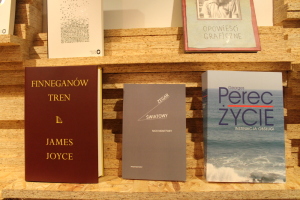 World Clock (book, code) has now been published in Polish. The translation is by Piotr Marecki, who translated the underlying novel-generating program and generated a new novel in Polish. ha!art is the publisher, and the book appears in the Liberatura series, which also includes some very distinguished titles: The Polish translations of Finnegans Wake and of Perec’s Life A User’s Manual, for instance.
World Clock (book, code) has now been published in Polish. The translation is by Piotr Marecki, who translated the underlying novel-generating program and generated a new novel in Polish. ha!art is the publisher, and the book appears in the Liberatura series, which also includes some very distinguished titles: The Polish translations of Finnegans Wake and of Perec’s Life A User’s Manual, for instance. 
A Zine View of the Trope Tank
My most unconventional lab is documented in a new zine by Sherri Wasserman, one available for download and screen-viewing now; it will be available in DIY print-and-bind-your-own format soon.
The publication is Restore [Return] Shift, and it’s the second in a series of zines documenting spaces that preserve and offer access to creative computing.
A rare color photo can be seen on the Instragram announcement.
More Human at Cyberarts
Here are some photos from the opening of the show More Human at the Boston Cyberarts Gallery on September 12.
The site for the show also features a PDF of the catalog [2.5 MB].
My piece in the show is From the Tables of My Memorie. I read a bit from the piece last night, when I spoke at Boston Cyberarts with several other artists about our work and the theme of the show.
I’ll be speaking at the Boston Cyberarts Gallery again on November 19, this time about ports and translations in computational art – the topic of my Renderings project. That event is at 7:30pm. The gallery is in the Green St T Station on the Orange Line.
HBS Last Week, Cyberarts This Week
I read from #! and two other books at the Harvard Book Store last Thursday.
This Wednesday (September 24), I’ll be one of ten artists speaking about work in the COLLISIONcollective show “More Human.” The Art Technology New England event is in the gallery where the show is up.
That’s the Boston Cyberarts gallery, 141 Green St, Jamaica Plain, Massachusetts 02130 – connected to the Green Street T Station on the Orange Line.
The event starts at 7:30pm and will probably go to about 10pm.
Code Poetry Slam in NYC Seeks Entries
ITP (the Interactive Telecommunications Program) at NYU is having a Code Poetry Slam on November 14. And they are seeking entries now! Send them along no later than November 7.
ELO 2015 in Bergen: Call for Participation
Call for Participation
THE END(S) OF ELECTRONIC LITERATURE
The 2015 Electronic Literature Organization conference and festival will take place August 5-7th 2015. The conference will be hosted by the Bergen Electronic Literature research group at the University of Bergen, Norway with sessions at venues including the University of Bergen, Det Akademiske Kvarteret, the Bergen Public Library, the University of Bergen Arts library, and local arts venues. Bergen is Norway’s second-largest city, known as the gateway to the fjords, a festival city and cultural center with a lively and innovative arts scene.
DEADLINES
The deadline for submissions of research, workshop, and arts proposals is December 15, 2014.
CONFERENCE THEME
The theme of the 2015 Electronic Literature Organization conference and festival is “The End(s) of Electronic Literature.” This theme plays on several different meanings of “ends.” Topics the conference papers and works will explore include:
Is “electronic literature” a transitional term that will become obsolete as literary uses of computational media and devices become ubiquitous? If so, what comes after electronic literature?
We can also question in what sense electronic literature and digital writing practices are a means to an end. If so, what are the ends of electronic literature? What political, ideological, aesthetic, and commercial ends or purposes do works of electronic literature serve?
In recent years, projects such as the ELMCIP Electronic Literature Knowledge Base have sought to highlight the work of scholars and artists who have worked outside of the mainstream of electronic literature as it has developed as a field, for instance developing research collections based on Russian and Brazilian electronic literature. This conference will seek to shed further light on international communities and practices in electronic literature that have not been widely addressed in the critical literature of the field, those that are located at the “ends” or margins of critical discourse in the field.
Electronic literature is situated as an intermedial field of practice, between literature, computation, visual and performance art. The conference will seek to develop a better understanding of electronic literature’s boundaries and relations with other academic disciplines and artistic practices.
As a laboratory for future literary forms, the field of electronic literature must count the youngest readers among its most significant group of end-users. One strand of this conference will focus specifically on digital reading experiences made for children.
RESEARCH PROGRAM
For the conference research program we welcome contributions that address the conference themes. Most proposals will likely describe a scholarly presentation suitable for delivery in about 20 minutes, with time for questions. However we also welcome propsals for other forms of talks. At the time of proposal submission, authors will asked identify one of following presentation formats:
Paper (20 minute presentation): a presentation of a single by one or more paper by one or more authors (500 word abstract)
Panel (75 minutes): a proposal for a complete panel including separate papers on the same general topic (250 word overview plus 3-4 500 word abstracts).
Roundtable (1 hour): a group presentation of a particular topic emphasizing free-flowing discussion and audience interaction (500 word abstract).
Lightning talk (5 minutes): a short paper for a session focused on the question “What comes after electronic literature?” (250 word abstract).
Proposers must attend the conference. Speakers may not present in more than two sessions.
Presentations may include elements of demonstration or performance, as part of a discussion that goes beyond the work itself. With this stipulation, proposers are welcome to address their own work.
Submissions for the research program will be accepted from September 15th-December 15th, 2014 on Easychair: https://easychair.org/conferences/?conf=elo2015
Proposals will be peer-reviewed by the Research Program Committee. Papers will be accepted on the basis of abstracts. Although we will not require, we will encourage authors of papers accepted for the conference to make full-text versions of their papers available on the conference site prior to the conference. Authors of selected full paper submissions may be invited to contribute to a book or special issue of a journal to be published shortly after the conference. This publication opportunity will not be available to authors who do not upload their full-text papers.
WORKSHOP PROGRAM
We welcome proposals for pre-conference workshops to take place on Tuesday, August 4th at the University of Bergen.
Workshop sessions are focused on hands-on group work on a given project. For instance, working with a particular platform to learn how to use it to create works of e-lit, documenting work in a given database, sharing pedagogical models, curating electronic literature, etc. Workshops sessions are generally half-day (3 hour) or full-day (6 hour) sessions.
Proposals will be reviewed by the Workshop Program Committee and selected on the basis of their value to the e-lit community and available facilities to accommodate them.
Submissions for the workshop program will be accepted from September 15th-December 15th, 2014 on Easychair: https://easychair.org/conferences/?conf=elo2015
ARTS PROGRAM
The Arts Program provides an occasion for juried review, and extended display, performance, and presentation, of original works.
The Committee especially welcomes submissions from artists who are new to electronic literature or who are in the beginning stages of their e-literary artistic production.
The Arts program will feature several exhibitions and a performance program that coheres with the conference themes. Submissions are being accepted for the following parts of the exhibition and performance program:
Hybridity and Synesthesia: Beyond Peripheries of Form and Consciousness
This aspect of the program will emphasize works, particularly installations, that push at the edges of literature and other forms, and that appeal to other aspects of the sensorium than those we typically associate with reading. Works for example that involve haptic sensation, touch-based interactivity, innovative audio elements, interactive images, or locative technologies.
Interventions: Engaging the Body Politic
This exhibition will feature works that engage with contemporary cultural discourse and political reality, challenging audiences to consider digital artifacts and practices that reflect and intervene in matters of the environment, social justice, and our relation to the habitus.
Decentering: Global Electronic Literature
While there are strong centers of activity in electronic literature in North America and Western Europe, innovations in digital textuality are also taking place in Eastern Europe and in the Southern hemisphere. This exhibition will focus on these lesser-known phenomena.
Kid-E-Lit: Digital Narratives for the Young
The first generation of digital natives is finding a plethora of apps and interactive digital narratives made for their iPads and computers, perhaps learning how to think in a new digital vernacular. This exhibition will focus on innovations in digital reading experiences for children.
Screening Room: E-Lit Film Festival
The first ELO film festival will feature films that have been produced recently about electronic literature and related practices, and will also include screenings of types of digital literature that benefit from sustained watching, such as poetry generators and kinetic poetry.
End(s) of Electronic Literature Performances and Readings
This aspect of the program will feature live readings and performances of works of electronic literature. Authors are encouraged to think broadly about modes of performance, ranging from traditional readings to more theatrical styles of presentation, and to consider opportunities for site-specific interventions in public space.
Submissions for above parts of the Arts program will be accepted from September 15th-December 15th on Easychair: https://easychair.org/conferences/?conf=elo2015
ELC3 Preview Exhibition
Volume 1 (2006) and Volume 2 (2011) of the Electronic Literature Collection have been influential anthologies that helped shape the field. Volume 3 (2016) is now open for submissions. This exhibition will feature selected works from the latest instantiation of this important publication. The editors of ELC3 will curate this selection. To submit work for the ELC3, see: http://eliterature.org/2014/08/announcing-the-elc3 (ELC3 submission deadline Nov. 5, 2014)
Selections will be made via a two-step jury review process. Members of the arts program committee will first review submissions, and then curators for each track of the program will select works from among those ranked most positively by the committee. Final selections will depend on available resources and constraints of individual venues.
See Submission Guidelines for further details.
ORGANIZATION
Conference Chair: Scott Rettberg
Research Program Chair: Jill Walker Rettberg
Arts Program Chair: Roderick Coover
Research Program Committee: Espen Aarseth, Daniel Apollon, Sandy Baldwin, Laura Borras Castanyer, Yra van Dijk, Maria Engberg, Nina Goga, Dene Grigar, Davin Heckman, Raine Koskimaa, Nick Montfort, Søren Pold, Øyvind Prytz, Hans Kristian Rustad, Jessica Pressman, Eric Dean Rasmussen, Scott Rettberg, Alexandra Saemmer, and Joseph Tabbi.
Workshop Program Committee: Deena Larsen, Marjorie C. Luesebrink, and Patricia Tomaszek.
Arts Program Committee: Simon Biggs, Philippe Bootz, Serge Bouchardon, Kathi Inman Berens, JR Carpenter, Mark Daniels, Anne Marthe Dyvi, Natalia Fedorova, Leonardo Flores, Chris Funkhouser, Dene Grigar, Claudia Kozak, Talan Memmott, Maria Mencia, Judd Morrissey, Scott Rettberg, Stephanie Strickland, Rui Torres, Michelle Teran, and Jeremy Welsh.
PLEASE CIRCULATE
If you know of friends, colleagues, or organizations not aware of ELO or this conference, please feel free to circulate this Call. A PDF version is available.
10 PRINT in Paperback
Hey, lookit here. Not only is 10 PRINT CHR$(205.5+RND(1)); : GOTO 10 (by Nick Montfort, Patsy Baudoin, John Bell, Ian Bogost, Jeremy Douglass, Mark C. Marino, Michael Mateas, Casey Reas, Mark Sample, and Noah Vawter, MIT Press, 2013) available for free online as a Creative Commons PDF, and available in the original harback edition that MIT Press published, it’s also now in paperback.
The paperback looks beautiful, by the way, thanks to the design work and attention of our co-author Casey Reas.
Here’s the MIT Press page with both the hardcover and the paperback.
A Platform Studies Book: Flash
I’m delighted that Flash: Building the Interactive Web by Anastasia Salter and John Murray has just been published by the MIT Press.
This is an excellent study of an influential software platform – our first such study in the Platform Studies series – and it both traces the history of the platform, its development and the contexts in which it arose, as it also covers many famous and representative Flash productions.
Mark Sample writes of it, “Combining historical research, software studies, and a deep appreciate for digital creativity, Salter and Murray dramatically explore Flash—whose very ubiquity has heretofore made it transparent to media scholars—as the defining technology for a generation of artists, storytellers, game designers, and Web 2.0 companies.”
Dene Grigar calls it “a must-read for all scholars and artists of digital media,” while Aaron Delwiche names it “the best and most provocative work I’ve encountered about emerging technologies since the publication of The Cyborg Handbook.”
Flash is still with us, but Salter and Murray nevertheless take up the difficult task of providing the historical context for this platform’s creation, from the days before it supported general-purpose programming through its dominance on the Web. The relevance of this book is not limited to a particular product (now, but not always, an Adobe product). It extends to the Web to interactive computing overall.
This Thursday! In Stereo!
I will be reading from and discussing three recent books this Thursday at 7pm the Harvard Book Store here in sunny Cambridge, Massachusetts. These are:
#!
Counterpath Press, Denver
a book of programs & poems (pronounced “shebang”)
World Clock
Bad Quarto, Cambridge
a computer-generated novel
10 PRINT CHR$(205.5+RND(1)); : GOTO 10
MIT Press, Cambridge
a collaboration with nine others that I organized, now out in paperback
These all express how programming can be used for poetic purposes, and how
new aesthetic possibilities can arise with the help of computing. Also,
some portions of these (which I’ll read from) are quite pleasing to read
aloud and to hear.
I would love it if you are able to join me on Thursday.
Patently Absurd
Sam Lavigne has an excellent text-generating, or at least -transforming, system that produces patent applications based on source texts. See, for instance, the one generated using Kafka’s “The Hunger Artist.” A full explanation of the code is provided on the page.


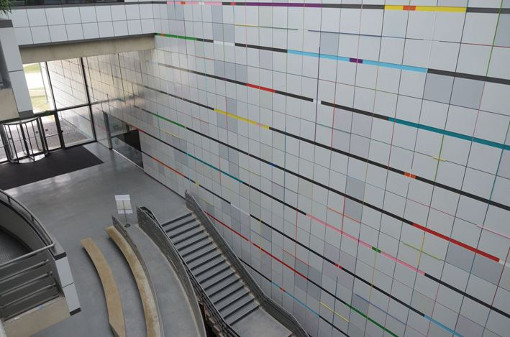
![From Restore [Return] Shift](http://nickm.com/post/wp-content/stuff/TT_zine.jpg)
